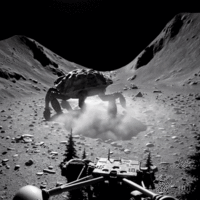Tarsica
| ||
| Orbital characteristics | ||
| Mass (Kg) | 9.45E+22 | |
| Radius (Km) | 1,737 | |
| Solar Day (h) | 327 | |
| Orbital Period (days) | 24.8 | |
| Semi-Major Axis (Km) | 384,399 | |
| Periapsis (AU) | .002 | |
| Apoapsis (AU) | .002 | |
| Albedo | .16 | |
| Surface Temperature (K) | 255 | |
| Surface Gravity (m/s^2) | 2.09 | |
| Axial Tile (degrees) | 8.1 | |
| Inclination (degrees) | 3.1 | |
| Orbital Speed (Km/s) | 9.27 | |
| Land/Sea Ratio | N/A | |
| Satellites | None | |
Tarsica, Micras' satellite, is roughly the same size as Earth's moon, Luna. And they both share roughly the same daily orbit around their planet sister. The similarities between Luna and Tarsica end here however. Unlike Luna, Tarsica has a very thin atmosphere and a small amount of plantlife. Just enough to keep the atmosphere stable and self-replenishing. Due to Tarsica being both a satellite and having a thin atmosphere, the planet remains perpetually cold. Almost all water on the surface is frozen, and liquid water underground has to be reached by drilling. Hardy evergreen plants dominate the flora of Tarsica, its short Gorgon Pines seen bending against the harsh Tarsican winds through viewers telescopes on Micras. Other plants remain mostly scrub, clinging to rock crevices or near open water. Both the climate and atmosphere remain in a perpetual tundra.
Basic Detail

The climate of Tarsica is attributed to it having a rich amount of water. Except for it being mostly frozen. The moon's core is only slightly volcanic, attributing to a number of underground water reservoirs. It does, however, remain to cold on the surface to keep water in its liquid form for very long. Only along Tarsica's equator can any liquid water be seen in amounts greater than a few square miles. The rest of the surface remains a rugged winter landscape, comparing to the higher altitudes of a mountain. Trees grow deep roots and may live to be hundreds of years old, yet grow no taller than a twelve or so feet. Thanks to the constant melting and re-freezing of water along the equator and in other "hot spots", Tarsica has plentiful snowfall. This has attributed to the common pet name of the "Christmas Moon".
North Polar Regions
The North Polar region of Tarsica is characterized by its relatively darker terrain interspersed with lighter patches. This region experiences cold temperatures, though the presence of dark areas suggests significant geothermal activity. The terrain is rugged, with a mixture of rock and ice formations. The lighter areas indicate ice caps or frost-covered regions, which contribute to the reflective surface. The interaction between the geothermal heat and the cold environment creates a dynamic and complex landscape.
Equatorial Regions
The Equatorial region of Tarsica presents a mix of greenish and brownish hues, indicating a temperate climate with varied terrain. The green areas suggest the presence of vegetation or algae, potentially in regions where liquid water is available. This region likely experiences moderate temperatures, suitable for sustaining diverse life forms. The brown areas indicate rocky plains and highlands, where the temperature is slightly higher. Occasional cloud cover and weather patterns, such as rainstorms, shape the landscape, leading to the formation of valleys and possibly river systems.
Southern Polar Regions
The South Polar region of Tarsica is marked by a combination of icy and rocky terrains, with a predominance of lighter, icy patches. This area experiences lower temperatures compared to the equator, leading to extensive ice coverage. The terrain is less rugged than the North Polar region, with smoother plains of ice. The presence of darker regions suggests that there could be geothermal vents providing localized warmth, which might lead to the formation of sub-surface liquid water lakes. The interplay between the ice and geothermal activity makes this region a point of interest for studying potential habitability and geological processes.
Species

Of fauna, Tarsica has little to none. Almost no birds are present except for small species similar to cardinals and chickadees which can survive the rigours of the cold and make their homes amid the small scrubbrush. All water on Tarsica is fresh rather than saline, attributing to most fauna clinging to the equatorial region. Of the largest species on Tarsica is the Polar Worm, an insect-like creature the size of a horse that prowls the wastes and eats grass and smaller insects. Smaller species are reputed to exist that, although not officially entered onto any taxonomy that enjoys current recognition, are referred to colloquially as "reindeer", "polar bears" and the like on account of their ostensible resemblance to creatures encountered in Micras' own boreal regions. The resemblance of these reputed creatures may be more apparent than real however, a testimony to the early explorers of Tarsica grasping for familiar comparisons. The best that might be said that these creatures, if they exist, is that they may inhabit similar ecological niches to those of their Micrasean counterparts, perhaps warranting the comparison. The low oxygen content in the atmosphere serves as a curb on the proliferation and size of complex biological organisms on the moon, affording scope to those who doubt the early accounts of exploration.
In the early 41.50s PSSC the Bassarid government - citing pressure from the international community - suppressed information regarding the existence of a large species known as the Tarsican Stone Crab. Although confirmed by Bassarid researchers who were able, during one of several missions to Tarsica, to photograph and to collect high quality partial specimens, the existence of the Stone Crab is rejected by researchers outside of the Bassarids, who nevertheless acknowledge the presence of the other species listed above, such as polar bears, reindeer, and the assuredly mythical polar worm.
If the Natopian mission on Tarsica, operating from New Lindstrom, ever encountered any of the reputed creatures listed above, it has not yet seen fit to communicate the news of such a discovery to the wider international community. Considering the flagrant intrusions of the safir into the Atos system, there cannot be said to be any meaningful taboo against discussing the independent evolution of life on other celestial bodies orbiting in the system. As such the reason for the presumed reticence on the subject may lie elsewhere.
Colonization Efforts
New Lindstrom
New Lindstrom is a research installation on the surface of Micras' moon, Tarsica. The colony is self-sufficient with large hydroponic bays, waste recyclers and below the surface ice extracting drills. A minor military attachment is stationed at New Lindstrom for defence and security of Natopian sovereignty on the base.
Visitors from nations on friendly terms with Natopia are welcome to tour and stay in New Lindstrom.
Lucien on Tarsica

Lucien on Tarsica is a Bassarid military installation established in secrecy as part of a joint effort by the New Zimian Space Exploration and Settlement Agency and the New Zimian War League in the early 39th era PSSC. The installation, which is used for research as well as a range of other operations, is located immediately between the two large equatorial lakes found along the southern rim of the Novaya-Sabir crater. The existence of this base is disputed and resented by members of the international community who doubt the validity and sophistication of Bassarid scientific research.
Lucien in Orbit
Lucien in Orbit is a small, planned space station currently under construction at Lucien on Tarsica's manufacturing and construction facilities. Once finished, Lucien in Orbit will orbit Tarsica at a relatively low altitude for a period of 10 years PSSC before crashing into the Tarsican surface.
Asteroid Impact of 50 PSSC

On 119/2/50 PSSC, at precisely 22:48, an asteroid struck the near side of Tarsica at 14.5°N, 47.3°E, unleashing an explosive force equivalent to 17 megatons of TNT. The event formed the Eye of Tarsica, a prominent crater measuring 2.3 kilometers in diameter and 300 meters deep. The intense heat generated by the impact melted subsurface rock, creating a reflective, glass-like surface within the crater. A vast ejecta blanket radiated outward, dispersing debris over a 50-kilometer radius and forming numerous secondary craters. The bright flash from the collision, visible across Micras, lasted approximately 8 seconds and marked one of the most significant lunar phenomena in recorded history. The visible changes to Tarsica’s surface immediately drew attention from scientists, spiritual leaders, and the general populace, setting the stage for profound cultural and scientific developments.
Scientific Observations
The asteroid impact offered unprecedented insights into Tarsica’s geological and seismic characteristics. Seismic waves generated by the collision were detected by instruments deployed by the New Zimian Space Exploration and Settlement Agency. Primary waves (P-waves) traveled at an average velocity of 6.5 km/s, indicating a dense, layered crust, while secondary waves (S-waves) revealed the presence of a semi-molten layer approximately 20 kilometers below the surface. These observations confirmed long-standing hypotheses about Tarsica’s internal structure and its geologic activity.
The impact exposed subsurface materials, including silicates, iron oxides, and magnesium-rich minerals, which were analyzed through orbital spectroscopy. The crater’s central peak, formed by the rebound of displaced crustal material, was composed of olivine and pyroxene, suggesting deep crustal origins. Volatile compounds such as carbon dioxide and sulfur dioxide were also detected, indicating the release of trapped gases from beneath the surface.
In addition to seismic activity, the impact caused a slight alteration in Tarsica’s rotational dynamics. Lunar laser ranging experiments detected a minor shift in axial precession of 0.00013 degrees, attributed to the redistribution of mass following the collision. The moon’s albedo increased slightly from 0.16 to 0.165, due to the highly reflective surface of the crater and the fine dust ejected across its surroundings. The event also provided a rare opportunity to study impact dynamics in real time, advancing models of lunar and planetary geology.
Ecological Impact
Despite the force of the asteroid strike, Tarsica’s ecosystems demonstrated remarkable resilience. The impact disrupted local vegetation and displaced animal life near the crater, but recovery was swift due to the adaptive nature of the moon’s organisms. The nutrient-rich soils exposed by the collision provided an ideal substrate for regrowth, allowing plant life to stabilize the altered terrain within weeks. Thermal energy released by the impact temporarily elevated surface temperatures, accelerating biological recovery processes and fostering biodiversity in the affected region.
The formation of fissures, secondary craters, and newly exposed rock layers created a variety of new ecological niches. These changes encouraged the redistribution of flora and fauna across the landscape, resulting in increased ecological diversity. Observations of this rapid recovery have provided valuable insights into the adaptability of life in extreme environments, furthering the study of astrobiology and lunar ecology.
Cultural and Mythological Significance
The impact of 119/2/50 PSSC quickly became a defining moment in Bassarid cosmology. The newly formed Eye of Tarsica, visible from Micras, was interpreted as a celestial message from the Lady Divine of Illumination and Wisdom, symbolizing vigilance and enlightenment. This interpretation reinforced Tarsica’s role as a spiritual and cultural icon within Bassarid society.
In the city of Luminaria, the event inspired the establishment of Taşrakah, or "Reverence of the Stone," a holiday celebrated annually on the 121st day of Thalassiel, the final day of the month. The holiday features nighttime vigils, ceremonial lantern processions, and communal reflections on resilience and cosmic balance. These observances center around the Eye of Tarsica, which has become a spiritual focal point for worshippers and pilgrims seeking to connect with the divine wisdom associated with the moon.
The Eye of Tarsica has further strengthened its significance as both a cultural symbol and a scientific curiosity. It serves as a reminder of the profound impact celestial events can have on both the physical and spiritual realms, bridging the gap between science and mythology in Bassarid society.
